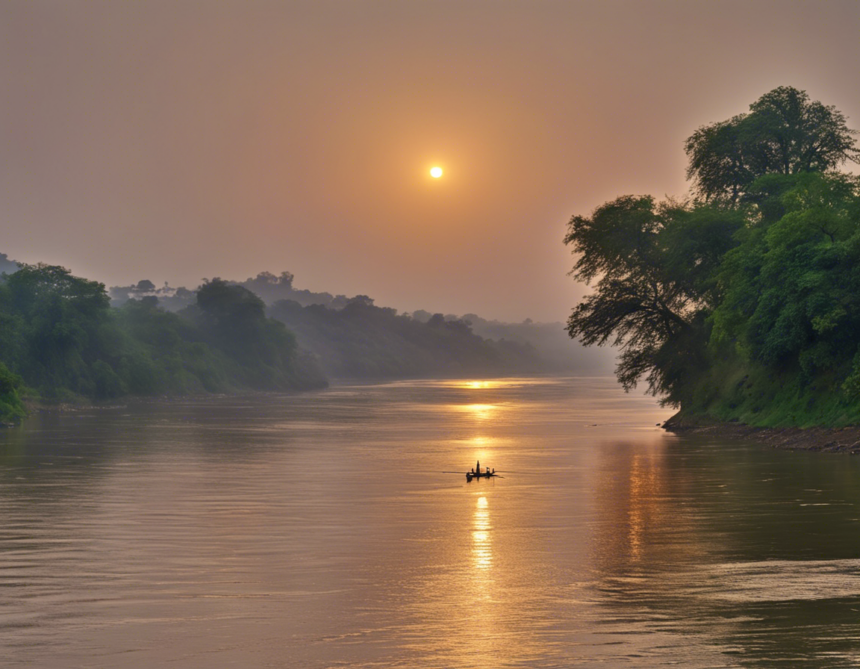Introduction
Narmada River, also known as Rewa, holds a special place in the hearts of millions of people in India. Originating from the Amarkantak Plateau in Madhya Pradesh, this sacred river flows through a distance of approximately 1,312 km before merging into the Arabian Sea. The Narmada River is not just a water body; it is a symbol of divinity, purity, and natural beauty. Let’s delve deeper into the mesmerizing world of the Narmada River.
Historical and Cultural Significance
The Narmada River finds mention in ancient Vedic texts and scriptures, attesting to its historical and cultural significance. Many mythological stories and legends are associated with this majestic river, making it a revered water body in Indian culture. The Narmada holds immense religious importance, with numerous temples and shrines located along its banks. The Narmada Parikrama, a traditional pilgrimage circumambulating the river, is undertaken by thousands of devotees seeking spiritual enlightenment and blessings.
Biodiversity and Eco-system
The Narmada River basin supports a rich biodiversity and eco-system, sustaining a variety of flora and fauna. The river is home to several species of aquatic life, including the famous Mahseer fish. The riparian forests along the Narmada River are teeming with diverse plant species, contributing to the overall ecological balance of the region. The conservation of the Narmada River and its eco-system is crucial to preserving the natural heritage of this unique water body.
Scenic Beauty and Landmarks
Traversing through picturesque landscapes and rocky terrains, the Narmada River offers breathtaking views and captivating scenery. The Marble Rocks of Bhedaghat, near Jabalpur, are a notable natural wonder where the river cuts through marble cliffs, creating a stunning gorge. The Dhuandhar Falls, cascading down with thunderous force, are another popular attraction along the Narmada. The famous Sardar Sarovar Dam, one of the largest dams in the world, provides irrigation water and hydropower while adding to the scenic beauty of the river.
Water Quality and Conservation Efforts
Despite its cultural significance and natural beauty, the Narmada River faces environmental challenges such as pollution and over-exploitation. Efforts are underway to improve the water quality of the river and ensure its sustainable management. Various initiatives, including wastewater treatment plants, afforestation drives, and community participation programs, aim to conserve the Narmada River for future generations. It is essential to raise awareness about the importance of preserving this natural wonder and protecting its pristine waters.
Recreational Activities and Tourism
The Narmada River offers a wide range of recreational activities and tourist attractions for visitors to explore and enjoy. From river cruises and boating expeditions to trekking in the nearby forests, there are plenty of opportunities for adventure enthusiasts. Pilgrimage tourism thrives along the Narmada, with pilgrims flocking to temples and ghats for religious ceremonies and rituals. The serene ambiance and tranquil surroundings of the Narmada River make it a popular destination for spiritual retreats and nature lovers alike.
Conclusion
In conclusion, the Narmada River stands as a testament to the beauty and majesty of nature, entwined with a rich tapestry of history and culture. This natural wonder not only sustains life along its banks but also inspires awe and reverence in all who behold its magnificence. It is our collective responsibility to preserve and protect the Narmada River for the generations to come, ensuring that its legacy of purity and serenity endures for eternity.
FAQs
- What is the significance of the Narmada River in Hindu mythology?
-
The Narmada River is believed to have originated from the sweat of Lord Shiva and is considered one of the holiest rivers in India.
-
How long is the Narmada River and where does it flow through?
-
The Narmada River is approximately 1,312 km long, flowing through the states of Madhya Pradesh, Maharashtra, and Gujarat before merging into the Arabian Sea.
-
What are some of the major tributaries of the Narmada River?
-
The major tributaries of the Narmada River include the Tawa, Kolar, Banjar, Shakkar, and Dudhi rivers.
-
What are some of the popular tourist attractions along the Narmada River?
-
The Marble Rocks of Bhedaghat, Dhuandhar Falls, Sardar Sarovar Dam, and Omkareshwar Temple are among the popular attractions along the Narmada River.
-
How is the water quality of the Narmada River being monitored and managed?
-
Water quality monitoring stations, pollution control measures, and community engagement programs are being implemented to improve the water quality of the Narmada River.
-
Is it safe to engage in water activities in the Narmada River?
-
It is advisable to follow safety guidelines and precautions while engaging in water activities in the Narmada River to ensure a memorable and safe experience.
-
What are some of the eco-friendly practices that can help in conserving the Narmada River?
-
Planting trees, reducing plastic pollution, promoting sustainable agriculture practices, and supporting local conservation efforts are some of the eco-friendly practices that can contribute to conserving the Narmada River.
-
Are there any famous festivals or events celebrated along the banks of the Narmada River?
-
The Narmada Jayanti, a festival celebrating the birth of the Narmada River, and the Narmada Mahotsav, a cultural event showcasing the heritage of the river, are among the famous festivals celebrated along its banks.
-
What are some of the ways to experience the spiritual essence of the Narmada River?
-
Taking a river cruise, participating in the Narmada Parikrama pilgrimage, attending evening aarti ceremonies at the ghats, and seeking blessings at the temples along the river are some ways to experience the spiritual essence of the Narmada River.
-
How can visitors contribute to the conservation efforts of the Narmada River?
- Visitors can support local conservation projects, practice responsible tourism, educate others about the importance of preserving the river, and participate in clean-up drives and awareness campaigns to contribute to the conservation efforts of the Narmada River.


Leave a Reply